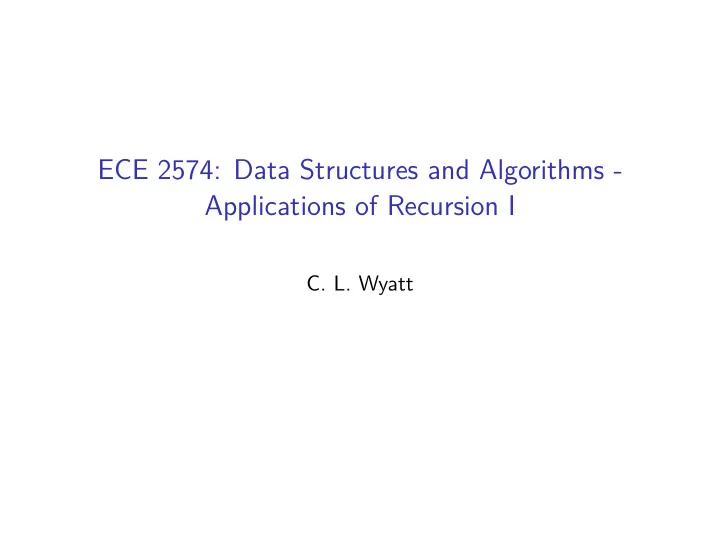

ECE 2574: Data Structures and Algorithms - Applications of Recursion I C. L. Wyatt
Today we will look a common task that is easily solved using a recursive solution, parsing algebraic expressions. ◮ Warmup ◮ Review of algebraic expressions ◮ converting between prefix and postfix expressions ◮ an implementation in C++
Why prefix or postfix notation? Many of you asked, in some form or another, why prefix or positfix notation? ◮ unambiguous, there are no operator precedence rules ◮ easy to parse (translate into a tree form) for evaluation ◮ supports operators with n-ary arguments with no additional syntax For this reason, prefix and postfix notation is used in many programming and data description languages ◮ languages in the Lisp family use prefix notation ◮ stack-based languages generally use postfix notation
Algebraic Expressions Lets say we are going to write a program to act as a calculator. For example: (a + b)*c (a/b)*c (a-b-c-d)/e How does the calculator decide if the expression is valid ?
Lets start with a less complex Algebraic grammar Prefix expressions . In prefix notation the operation is written first, followed by the two operands. Examples: ◮ * + a b c in infix notation is (a + b)*c ◮ + / a b - c d in infix notation is (a / b) + (c - d) The grammar looks like: <prefix> = <operand> | <operator> <prefix> <prefix> <operator> = + | - | * | / <operand> = a | b | c | .... | z
Validation of a prefix expression using recursion <prefix> = <operand> | <operator> <prefix> <prefix> <operator> = + | - | * | / <operand> = a | b | c | .... | z Base step is simple: check for operator at string beginning. The recursive step is a little more complicated. The key is that if <prefix> is a valid prefix <prefix><ch> , where <ch> is any non-blank character, is not.
Validation of a prefix expression using recursion function endPre(in s:string, in first:int): int last = s.length() - 1 if( first < 0 or first > last ) return -1 ch = first char of s if(ch is an operand) return first else if(ch is an operator) firstEnd = endPre(s, first+1); if(firstEnd > -1) return endPre(s, firstEnd +1) else return -1 else return -1 endfunction
Using the endPre function to validate the grammar Call endPre at first character in the string if the last character returned is not the last one it is not a valid prefix expression. function isPre(in s:string): bool lastChar = endPre(s, 0) return lastChar >= 0 AND lastChar == s.length()-1 endfunction
Warmup #1 Is the following string a valid prefix expression? / + a c d - e g False (53% correct)
Similar is the postfix notation <postfix> = <operand> | <postfix> <postfix> <operator> <operator> = + | - | * | / <operand> = a | b | c | .... | z Suppose we wanted to convert the prefix expression to a postfix expression. <postfix> = <operand> | <postfix> <postfix> <operator> <prefix> = <operand> | <operator> <prefix> <prefix>
A recursive solution to conversion function convert(in pre:string, out post:string) ch = first character of pre delete first character of pre if ch is an operand post = post + ch //concatenate else // recursion to convert 1st convert(pre, post) // recursion to convert 2nd convert(pre, post) // concatenate the operator post = post + ch endif endfunction
Validating a postfix expression function endPost(in s:string, in last:int): int first = 0 if( first > last ) return -1 ch = last char of s if(ch is an operand) return last else if(ch is an operator) lastEnd = endPost(s, last-1); if(lastEnd > -1) return endPost(s, lastEnd-1) else return -1 else return -1 endfunction
Validating a postfix expression: isPost Call endPost at last character in the string if the last position returned is not zero it is not a valid postfix expression. function isPost(in s:string): bool firstChar = endPost(s, s.length()-1) return firstChar == 0 endfunction
Warmup #2 Is the following string a valid postfix expression? h r * R f - + t g - e f / * False (49% Correct)
A recursive solution to conversion the other way function convert(in post:string, out pre:string) ch = last character of post delete last character of post if ch is an operand pre = pre + ch //concatenate else // concatenate the operator pre = pre + ch // recursion to convert 1st to temp convert(post, temp) // recursion to convert 2nd convert(post, pre) pre = pre + temp // append temp endif endfunction
Warmup #3 Convert the following prefix expression to a postfix expression. + * A B / C D A B * C D / + (80 Correct)
Exercise: Implementing and testing in C++ See website.
Next Actions and Reminders ◮ Read CH pp. 172-186. ◮ There is no warmup for Monday. ◮ Program 1 is due Wed at 11:55pm via Canvas . ◮ If you have used all your late days, you must turn it in on time.
Recommend
More recommend